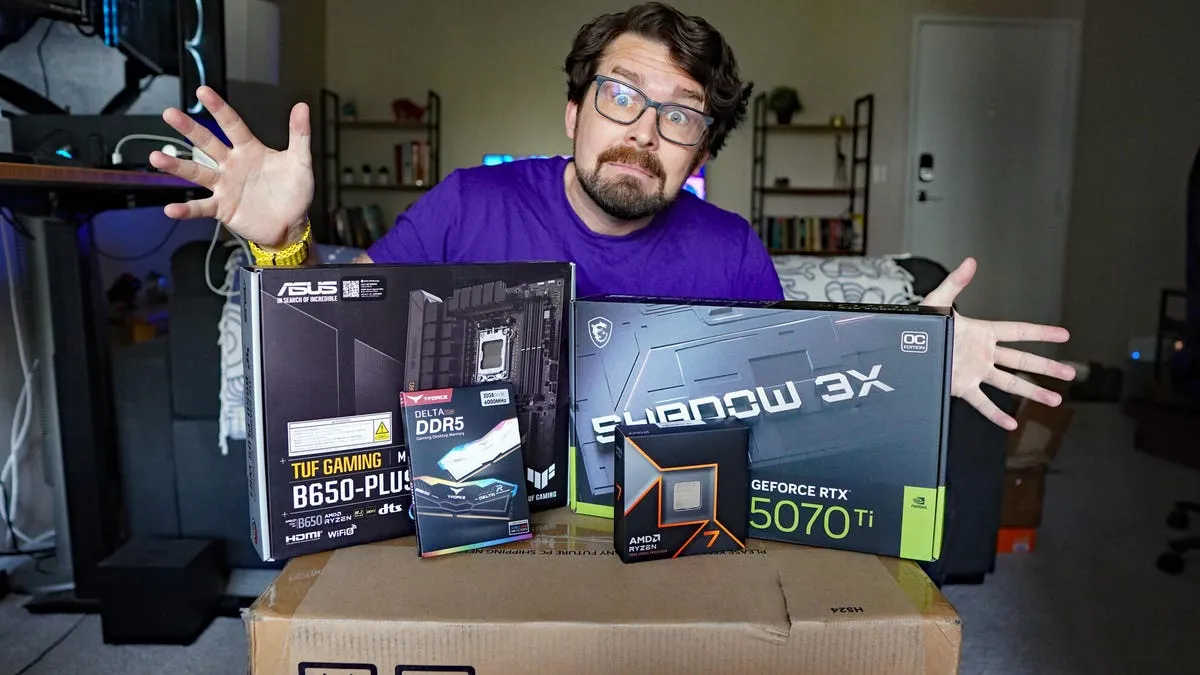
Three weeks ago, while gazing at the custom-built PC I assembled in the summer of 2020, I was hit with a wave of game preview invites that my aging rig simply couldn’t handle. Shortly after, President Donald Trump announced an unprecedented series of tariffs on imports, stirring up confusion in the tech community. In what I felt was a moment of rational choice, I ended up panic-buying a prebuilt PC, a decision not typically advised when it comes to tech purchases. However, with lingering pandemic-related supply chain issues, my response felt almost instinctual.
As Trump's tariffs were implemented and then momentarily paused for 90 days—especially affecting imports from China, a major source of PC components—many consumers were left uncertain. While it may seem prudent to rush out and purchase items that could soon see price hikes, the reality is that, for the moment, prices have remained stable. In fact, according to Ryan Reith, Group Vice President for the International Data Corporation, the trend is quite the opposite; consumers are not buying enough. Reith noted that although there may be some panic buying, inventory levels are expected to be sufficient as we head into July.
In a moment of haste, I consulted various Discord groups and conducted some quick research, ultimately choosing a prebuilt NZXT PC priced at $2,000. This setup featured a Ryzen 7 9700X CPU, Nvidia GeForce RTX 5070, and 32GB of DDR5 RAM, ideal for my gaming needs over the next four to five years. I considered upgrading my old system—a Ryzen 5 3600 CPU, Nvidia GeForce GTX 1080, and 16GB of DDR4 RAM—but upon learning about the potential rollback of tariffs, I took a step back to reassess my decisions.
After clarifying some misconceptions about my NZXT H510 Elite case and its compatibility with current midrange GPUs, I realized I could enhance my existing setup without a complete overhaul. I could have upgraded my GPU, CPU, and RAM for around $700 to $800 for a moderate boost, but I opted for a complete rebuild to ensure my system was future-proofed for five years or more. With fingers crossed, I invested $1,600 in new parts and began the rebuilding process, hoping to avoid any catastrophic errors.
As I write this, I can confirm that my new-and-improved PC is operational and intact. However, the journey was filled with stress, research, and last-minute adjustments to my component choices. From understanding the latest in PC parts to navigating the complex landscape of global trade, it became clear that no one—be it consumers, manufacturers, or analysts—has a definitive playbook for upgrading your PC during such tumultuous times. The looming threat of tariff-induced price spikes added to the uncertainty, leaving me to contemplate whether my hasty decisions would pay off in the long run.
Reflecting on my experience, I discovered several key insights. First, I learned that the supply of PC components is not disappearing overnight, and many retailers have ample inventory. Additionally, some retailers have begun bundling deals, potentially offering savings. The ever-shifting nature of tariffs means that while prices may rise, a sudden resolution could alleviate the pressure on consumers. Importantly, the situation remains fluid, and it’s crucial to make informed decisions without relying solely on market trends.
If you're new to building a PC, it’s essential to understand the fundamental components that make up a desktop computer. Each part is designed to work in harmony, enabling you to run today’s top games. However, selecting the right components is more intricate than merely setting a budget. The performance of your PC is largely determined by screen resolution and frame rate, which dictate the quality of your gaming experience.
Today's gaming begins at 1080p (Full HD), progressing to 1440p (Quad HD) and culminating in 4K UHD (2160p). The frame rate is equally important, with 60 frames per second being the bare minimum acceptable to most gamers. For my goal of achieving 1440p gaming at 144 fps, I anticipated spending between $600 to $800 on a suitable GPU. The challenge lay not just in choosing the GPU but also in ensuring compatibility with my older components, such as the power supply and liquid cooler.
After days of feverish research, I settled on components that closely mirrored those found in prebuilt PCs within my budget. This included an AMD Ryzen 7 9700X CPU, an Nvidia GeForce RTX 5070 Ti, and 32GB of TeamGroup T-Force DDR5 RAM. However, my old motherboard was incompatible with the new CPU and RAM, necessitating an upgrade to an Asus Tuf Gaming B650-Plus Wi-Fi motherboard. My total expenditure was around $1,650.
While I may have overpaid for some components, particularly the GPU, I felt confident that my new setup was a worthwhile investment. The parts I selected will not only allow me to enjoy current games but also position me well for future releases. The rebuilding process, although frustrating at times, proved to be an enlightening experience, enhancing my understanding of PC hardware and contributing to my gamer cred.
With ongoing tariff uncertainty, determining the right time to purchase PC components is challenging. It involves analyzing past trends while anticipating future shifts in policy. Experts, including those at IDC, note that many manufacturers are still grappling with uncertainty, making it difficult to predict the impact of tariffs on consumer prices. As companies work to adjust their inventory strategies, I encourage fellow gamers to consider their own needs carefully before making any rash purchases.
Ultimately, my old PC has been rejuvenated, and the gaming experience is better than ever, delivering stunning graphics and high frame rates. While the market remains unpredictable, my upgrade journey has taught me valuable lessons about patience and informed decision-making in a rapidly changing landscape.